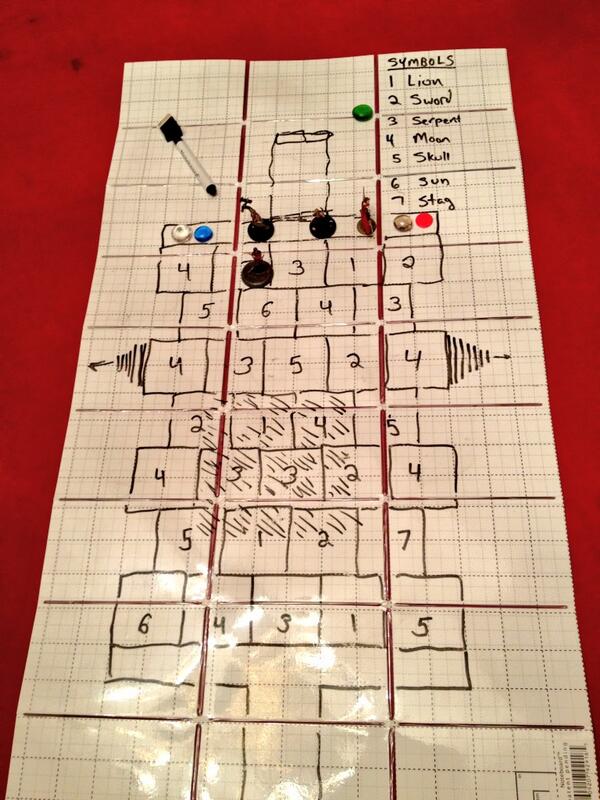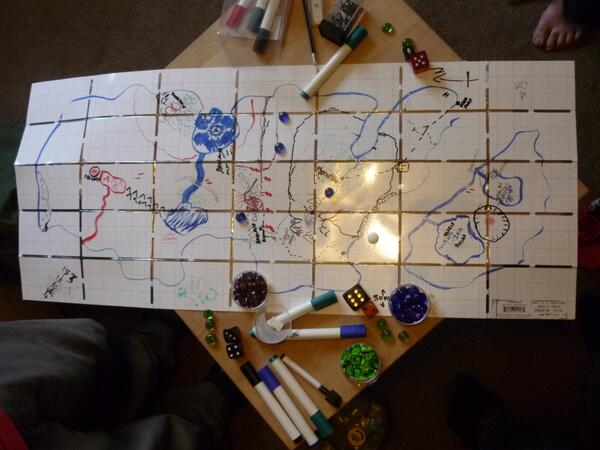 For my current 13th Age rpg campaign (a short break from our Ashen Stars game) I recently created several battle maps, because while the game does not use a grid movement, it profits from a good visualization of the combatant’s positions relative to each other. Looking back I realize that I used a variety of different ways to actually bring the maps to the table, as time and resources dictated. I thought it might be useful to look at the different methods.
For my current 13th Age rpg campaign (a short break from our Ashen Stars game) I recently created several battle maps, because while the game does not use a grid movement, it profits from a good visualization of the combatant’s positions relative to each other. Looking back I realize that I used a variety of different ways to actually bring the maps to the table, as time and resources dictated. I thought it might be useful to look at the different methods.
For the first session, I had a generous time frame and needed to have some professional posters done anyway, so I went for the most luxurious way: I had the two battle maps for the game printed at a poster printing service (Posterjack.com). Click on the image on the right, to see a close up view. The paper quality is great, the colors brilliant and of course everything is in one piece. The scale can be a bit off, if you go for the cheapest poster size/format option, but this map was not meant to be printed at exact miniature scale anyway. The downside: it’s a bit more expensive of course (€10 per 80cm by 60cm poster) and takes time get printed and sent back.
 For the second session I was much more pressed for time, and I also didn’t want to spend that kind of money again. So I went to my trusty home inkjet printer (a Canon Pixma iP4800) and printed the next battle map on nine pages of A4, trimmed and glued them together. You can see the result on the left.
For the second session I was much more pressed for time, and I also didn’t want to spend that kind of money again. So I went to my trusty home inkjet printer (a Canon Pixma iP4800) and printed the next battle map on nine pages of A4, trimmed and glued them together. You can see the result on the left.
The colors are more muted, and you can see where the pages have been glued together, but it still looks very nice. Of course it uses up a good bit of ink and still requires some time to assemble (I can do these in 10 minutes now though). Generally, this is my go to method, which I have used over the whole Deadlands Reloaded campaign that I finished last year.
 Still, I had a couple more encounters planned for the evening and didn’t want to print even more stuff. So I came up with a new way to use the map at the table. I would display it on the TV screen for all the players to see and have a Noteboard on the table with a quick sketch of the same map. The TV display would provide the flavor and atmosphere for the map, while the Noteboard would allow for the tactical positioning. Click on the image on the right to see the set up.
Still, I had a couple more encounters planned for the evening and didn’t want to print even more stuff. So I came up with a new way to use the map at the table. I would display it on the TV screen for all the players to see and have a Noteboard on the table with a quick sketch of the same map. The TV display would provide the flavor and atmosphere for the map, while the Noteboard would allow for the tactical positioning. Click on the image on the right to see the set up.
I used Chromecast and my Android phone to quickly cast images to the screen. This turned out quite well, better than expected on my rather modestly-sized TV set, and I used it for the final two encounters of the adventure. I’m sure I’ll revisit this method in upcoming sessions. While it’s not quite as nice as having the minis on the color map, it definitely saves on money and time.
Note that the Noteboard area is a bit smaller than your A1 poster map, but with 13th Age you don’t mind really. There is no counting of squares or hexes nor any measuring of distance that would need an accurate and consistent scale.



